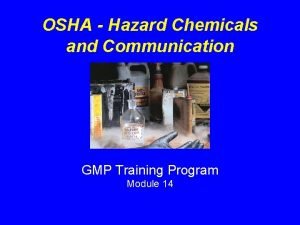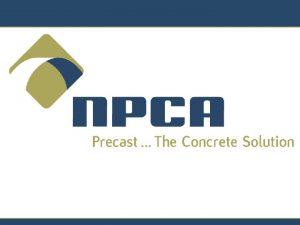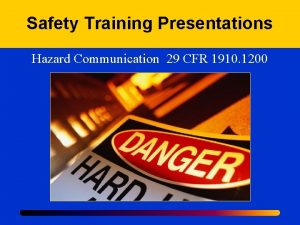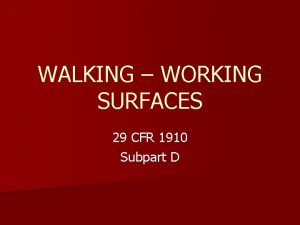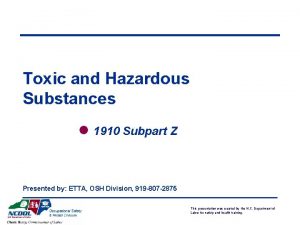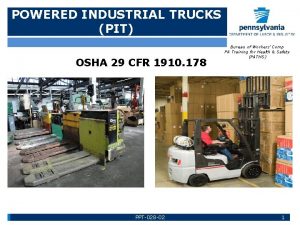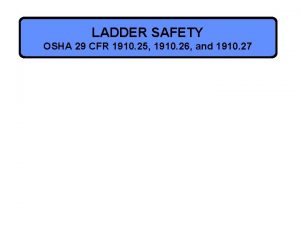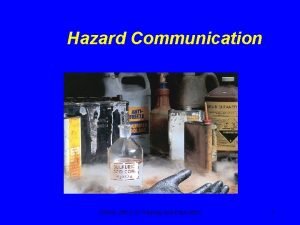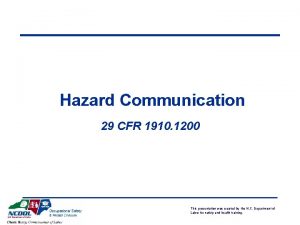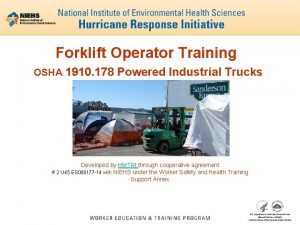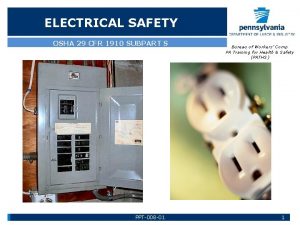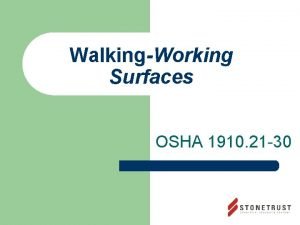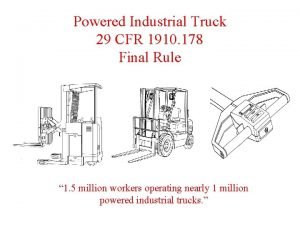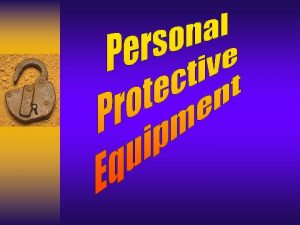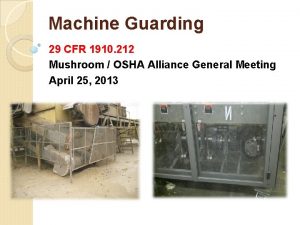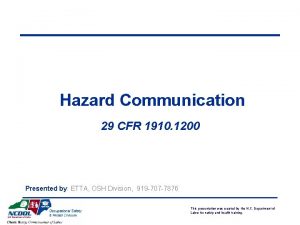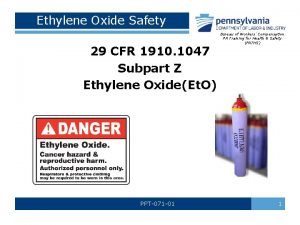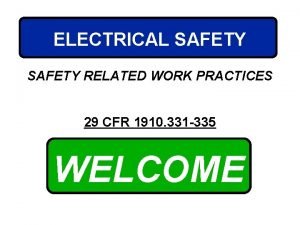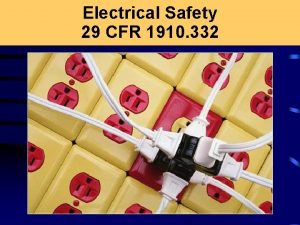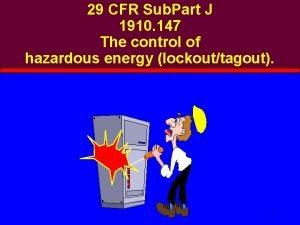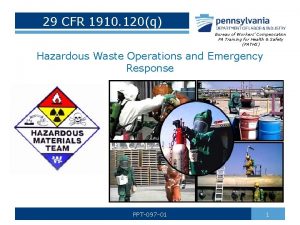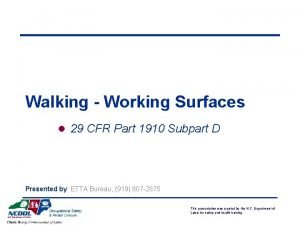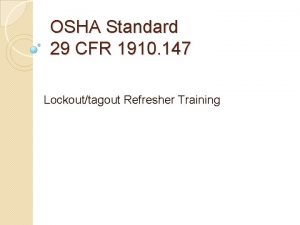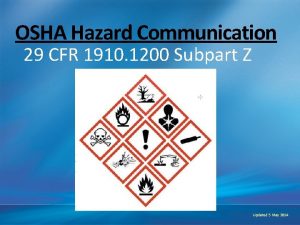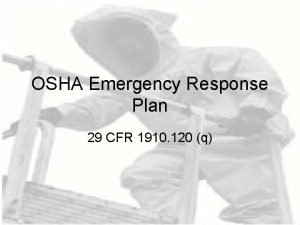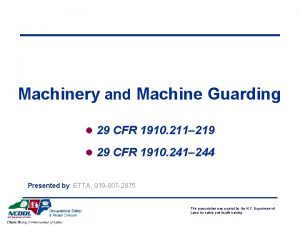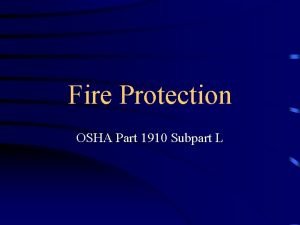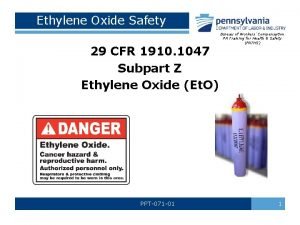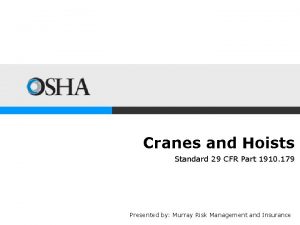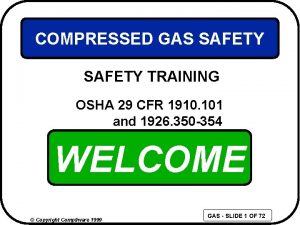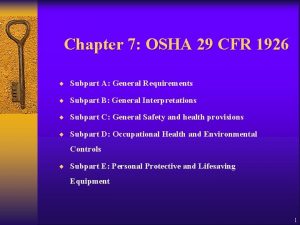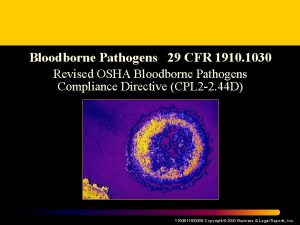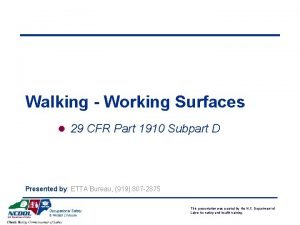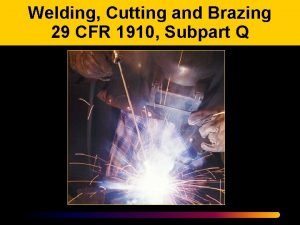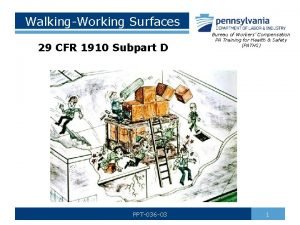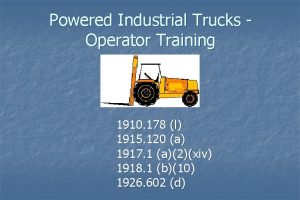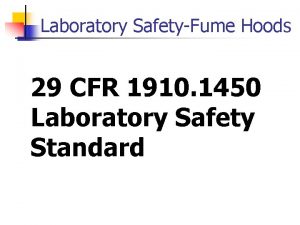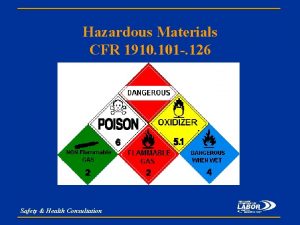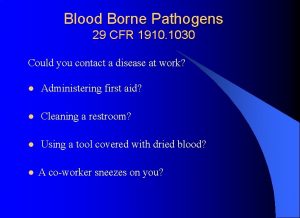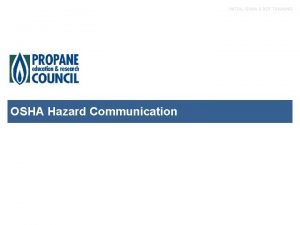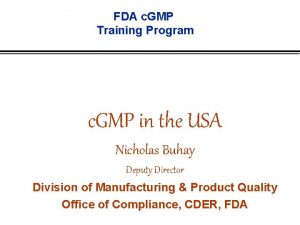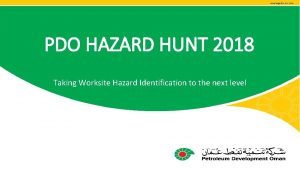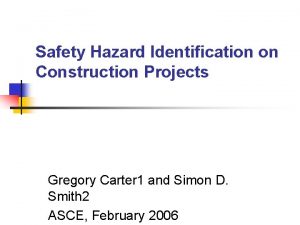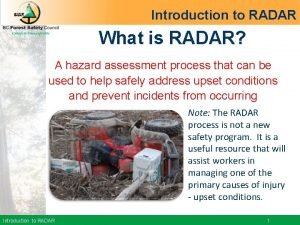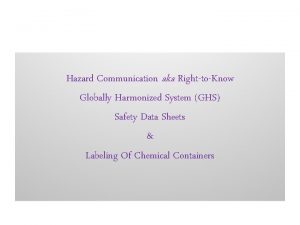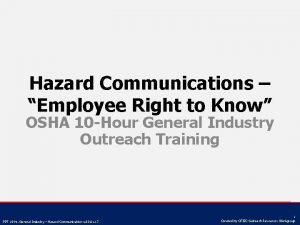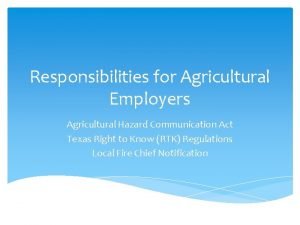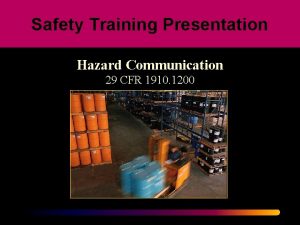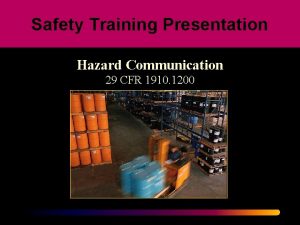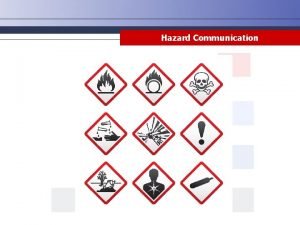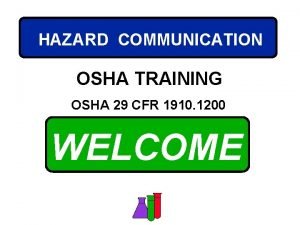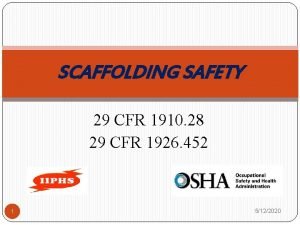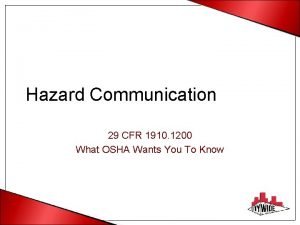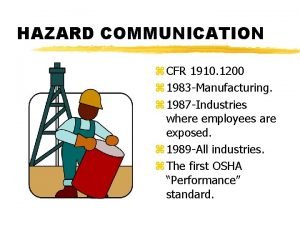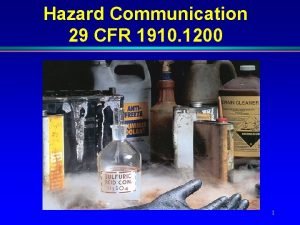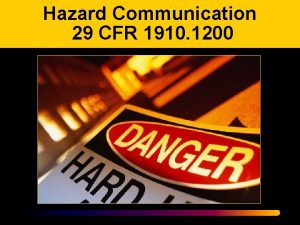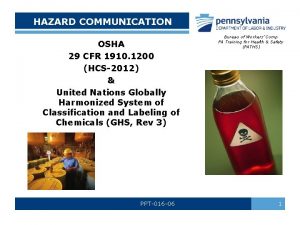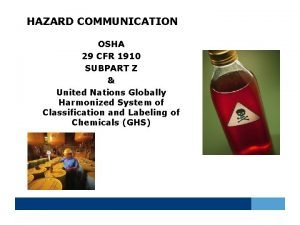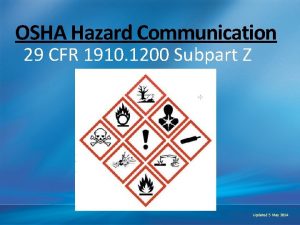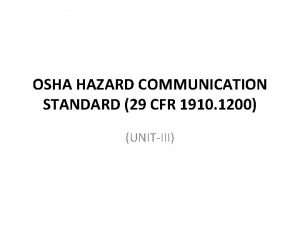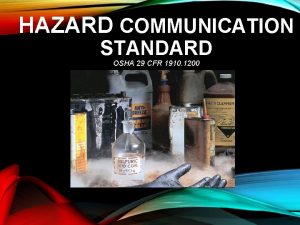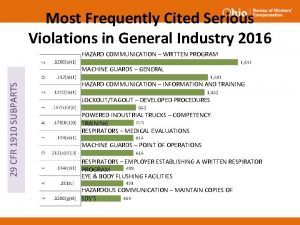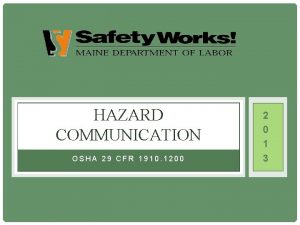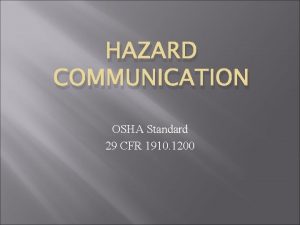Safety Training Presentation Hazard Communication 29 CFR 1910





















































- Slides: 53

Safety Training Presentation Hazard Communication 29 CFR 1910. 1200

Chemical Hazard n ESTIMATED 575, 000 EXISTING n CHEMICAL PRODUCTS n HUNDREDS INTRODUCED EACH YEAR

Close Encounters w/ Chemicals n Many employees encounter chemicals almost every day –Filling equipment with gasoline or diesel –Cleaning the bathroom –Applying pesticides or insecticides –Using solvents or acids at work n Many chemicals can cause injury or illness if not handled properly

Hazard Communication Goals n Right to know chemical hazards n Personal protective equipment (PPE), first aid, spills/leaks n Labels, material safety data sheets (MSDS) n Quiz

Right to Know n OSHA created the Hazard Communication Standard to help ensure the safety of employees when working with hazardous chemicals n You have a RIGHT TO KNOW about the hazardous chemicals you use on the job and how to work safely with those chemicals

Hazard Communication Standard n Chemical manufacturers must: –Determine a chemical’s hazards –Provide labels and MSDSs n Employers must: –Provide a hazard communication program –Maintain MSDSs –Train on the use of hazardous materials

Hazard Communication Standard (cont. ) n Employees must: –Read labels and MSDSs –Follow employer instructions and warnings –Identify hazards before starting a job –Participate in training

Chemical Hazards Physical Hazards: n Flammable n Explosive n Reactive Health Hazards: n Corrosive n Toxic

Routes of Entry n ABSORPTION n Inhalation n INGESTION

Chemical Exposure n Dosage n Acute effects –quickly apparent of the chemical as a result of shortterm exposure and are of short duration n Chronic effects – generally result from long-term exposure. The effects may not be immediately apparent and are likely to be of long duration.

AMOUNT AND TIME DOSE MAKES THE POISON - TABLE SALT EXAMPLE ADULT AMOUNT TIME EFFECT SMALL LONG NONE LARGE SHORT DEATH

THE NATURE AND STATES OF CHEMICAL HAZARDS TYPE OF MATERIAL UNITS OF MEASURE Dusts Millions of Particles per cubic foot Mineral - Sand Organic - grains Mass per unit of air (Milligram/cubic meter of air - mg/m 3)

THE NATURE AND STATES OF CHEMICAL HAZARDS TYPE OF MATERIAL UNITS OF MEASURE Mists Mass per unit of air Acid Mist Milligram/cubic meter of air - mg/m 3

THE NATURE AND STATES OF CHEMICAL HAZARDS TYPE OF MATERIAL UNITS OF MEASURE Fumes Mass per unit of air Welding Milligram/cubic meter of air - mg/m 3

THE NATURE AND STATES OF CHEMICAL HAZARDS TYPE OF MATERIAL UNITS OF MEASURE Fibers Mass per unit of air Cotton Dust Asbestos Milligram/cubic meter of air - mg/m 3 or Fibers per unit of air fibers/cubic centimeter of air - f/cc

THE NATURE AND STATES OF CHEMICAL HAZARDS TYPE OF MATERIAL UNITS OF MEASURE Gases Parts per million parts of air - ppm Carbon Monoxide ppm

THE NATURE AND STATES OF CHEMICAL HAZARDS TYPE OF MATERIAL UNITS OF MEASURE Vapors Parts per million parts of air - ppm Solvent or mass per unit of air (milligrams/cubic meter of air - mg/m 3)

EVALUATING THE RISK OF CHEMICAL EXPOSURES n THRESHOLD LIMIT VALUES (TLV’s) n PERMISSIBLE EXPOSURE LIMITS (PEL’s)

EVALUATING THE RISK OF CHEMICAL EXPOSURES SHORT TERM EXPOSURE LIMIT - STEL SHORT PERIOD OF TIME WITHOUT SUFFERING IRRITATION, CHRONIC/IRREVERSIBLE DAMAGE CEILING LIMITS A LIMIT THAT SHOULD NOT BE EXCEEDED

EVALUATING THE RISK OF CHEMICAL EXPOSURES n Flash point n Lower explosive limit (LEL) n Upper explosive limit (UEL)

CONTROLLING THE SPECIAL RISK OF SELECT CHEMICAL EXPOSURES SUBPART Z, 1910. 1001 -1450 CHEMICAL MATERIAL WORKPLACE EXPOSURES ARSENIC BLOODBORNE PATHOGEN ASBESTOS CHEMICAL HYGIENE FOR CADMIUM LABORATORIES COTTON DUST HAZARD COMMUNICATION FORMALDEHYDE LEAD BIS CHLOROMETHYL ETHER

Sign and Symbol Examples

Hazardous Materials First Aid n Eyes: Flush with water for 15 minutes n Skin: Wash with soap and water n Inhalation: Move to fresh air n Swallowing: Get emergency medical assistance

Spills and Leaks n Evacuate the area n Notify a supervisor or the emergency response team n Remove ignition sources (if safe to do so) n Stay away

Properly Labeled?

Importance of Labels n The identity of the chemical n Name, address, and emergency phone number of the manufacturer n Physical and health hazards n Special handling instructions n Basic PPE recommendations n First aid, fire response, spill cleanup

NFPA Labeling Systems n National Fire Protection Association = NFPA n Blue = Health n Red = Flammability n Yellow = Reactivity n White = Other hazards or special handling Scale: 0 (No Hazard) to 4 (Extreme Hazard)

NFPA Labeling Systems n. Chemical Hazard Label

NFPA Labeling Systems 2 4 0 3 4 0 Least Serious 4 Most Serious Flammable vapor which burns readily Substance is stable

NFPA Labeling Systems Burns readily. (Label for Diborane, B 2 H 6) May detonate with heat or ignition. Severe health risk. Avoid water.

NFPA Labeling Systems

NFPA Labeling Systems Complete Label for Phosphine (phosphorus hydride, PH 3)

MSDS n Reading an MSDS locations n Finding a specific MSDS

MSDS (cont. ) n Product Information n Hazardous Ingredients n Physical Properties n Fire and Explosion Hazard Data n Reactivity Data n Health Hazard Data n Precaution for Safe Handling and Use n Control Measures

MSDS (cont. ) n Health hazards – Routes of entry – Exposure levels (PEL or TLV) – Symptoms of exposure – First-aid and emergency information

MSDS (cont. ) n PPE n Safe handling and storage n Spills and leaks n Compliance issues

Hazard Communication Summary n Identify chemical hazards by reading labels and MSDSs n Follow warnings and instructions, or ask your supervisor if in doubt n Use the correct PPE n Practice sensible, safe work habits n Learn emergency procedures n Update the MSDS every 2 years

Hazard Communication Summary

THE PRINCIPLES OF OCCUPATIONAL HEALTH ARE BASED UPON n n n ANTICIPATING, RECOGNIZING, EVALUATING, CONTROLLING WORKPLACE HAZARDS

PPE n Dust masks and respirators n Glasses, goggles, and face shields n Gloves n Foot protection n Aprons or full-body suits

Personal Protective Equipment

Types of Eye Protection Goggles provide the most protection, forming a seal against the face. Laser goggles have wavelength-Types of Eye Protectionspecific lenses and opaque non-lens components.

Chemical splash in the eyes! • Flood eyes with copious amounts of water at eyewash for at least 15 minutes, then seek medical attention.

Hand Protection n Glove materials (PVA nitrile, butyl, PVC) show different degrees of resistance to chemicals n Heavier gloves = greater chemical resistance, but less dexterity n Thin exam gloves (esp. latex) provide almost NO chemical resistance n See MSDS for proper glove selection

Compressed Gas Cylinders

Chemical Suit Protection

Chemical Suit Protection


Chemical Inventory

Quiz 1. Chemical manufacturers must label containers and provide ________________. 2. Employers should keep MSDSs in a locked file cabinet. True or False 3. Dizziness, nausea, rashes, and respiratory irritation are signs of ___________exposure. 4. List three routes by which a chemical can enter the body: _____________, and _______. 5. Household chemicals are never as hazardous as chemicals used at work. True or False

Quiz (cont. ) 6. On NFPA labels, a 4 in the red diamond indicates an extreme health hazard. True or False 7. Typical first aid for chemicals splashed in the eyes includes ________________. 8. You will only know the health hazards and PPE requirements if you ___________. 9. A ___________ can be used to protect against breathing hazardous vapors or gases. 10. If you see a chemical spill, you should clean it up immediately. True or False

Quiz Answers 1. MSDSs must be provided by the manufacturer. 2. False. MSDSs must always be accessible to the employees. 3. These are all symptoms of acute effects, or short-term exposure. 4. The primary routes by which chemicals enter the body are skin and eye contact, inhalation, and swallowing. 5. False. Many household chemicals are more hazardous than chemicals found at work.

Quiz Answers (cont. ) 6. False. The red diamond indicates flammability hazards, not health hazards. 7. Typical first aid for chemicals splashed in the eyes includes flushing the eyes for 15 minutes. 8. You must read the labels and MSDSs to learn how to protect yourself from the hazards of a chemical. 9. Respirators protect against breathing hazardous vapors and gases. 10. False. Only attempt to clean a chemical spill if you’ve been properly trained.
 Osha hazard and ghs training regulation cfr 1910
Osha hazard and ghs training regulation cfr 1910 29 cfr 1910 section 1200
29 cfr 1910 section 1200 Cfr1910.1200
Cfr1910.1200 Hazard communication safety training quiz answers
Hazard communication safety training quiz answers 29 cfr 1910 subpart d
29 cfr 1910 subpart d 29 cfr 1910 subpart z
29 cfr 1910 subpart z 29 cfr 1910
29 cfr 1910 29 cfr 1910
29 cfr 1910 Osha cfr 1910 is the standard for______.
Osha cfr 1910 is the standard for______. Osha 1910 psm
Osha 1910 psm 29 cfr 1910 osha 178
29 cfr 1910 osha 178 29 cfr 1910
29 cfr 1910 Osha 1910 housekeeping
Osha 1910 housekeeping 29 cfr 1910 powered industrial trucks
29 cfr 1910 powered industrial trucks 29cfr1910.132
29cfr1910.132 1910 machine guarding
1910 machine guarding 29 cfr1910.1200
29 cfr1910.1200 29 cfr 1910 powered industrial trucks
29 cfr 1910 powered industrial trucks What is ethylene oxide
What is ethylene oxide 29 cfr 1910
29 cfr 1910 A person usually offers the most resistance to electricity
A person usually offers the most resistance to electricity 29 cfr 1910
29 cfr 1910 29 cfr1910.120
29 cfr1910.120 Osha fall protection 1910
Osha fall protection 1910 1910 147
1910 147 29 cfr 1910 section 1200
29 cfr 1910 section 1200 1910-120
1910-120 Cfr 29 1910
Cfr 29 1910 Osha subpart for fire protection and prevention
Osha subpart for fire protection and prevention 49 cfr 1910
49 cfr 1910 29 cfr part 1910
29 cfr part 1910 29 cfr 1910 compressed gas cylinder storage
29 cfr 1910 compressed gas cylinder storage Osha 29 cfr 1910 1200
Osha 29 cfr 1910 1200 Bloodborne pathogens standard 29 cfr 1910
Bloodborne pathogens standard 29 cfr 1910 29 cfr part 1910
29 cfr part 1910 29 cfr 1910 subpart q
29 cfr 1910 subpart q Osha 29 cfr 1910 subpart d
Osha 29 cfr 1910 subpart d 29 cfr 1910 osha 178
29 cfr 1910 osha 178 29 cfr 1910 ppe
29 cfr 1910 ppe 29 cfr 1910 osha 178
29 cfr 1910 osha 178 29 cfr 1910.
29 cfr 1910. Osha 1910 psm
Osha 1910 psm 29 cfr 1910 1030
29 cfr 1910 1030 Osha hazard communication initial training
Osha hazard communication initial training Safety care behavioral safety training
Safety care behavioral safety training 21 cfr 211 training requirements
21 cfr 211 training requirements Hazard hunt examples
Hazard hunt examples Gregory carter
Gregory carter Touch current vs leakage current
Touch current vs leakage current The safest ladder to use around electricity is:
The safest ladder to use around electricity is: Hazard communication quiz answers
Hazard communication quiz answers Hazard communication quiz answers
Hazard communication quiz answers Hazard communication ppt
Hazard communication ppt Texas hazard communication act
Texas hazard communication act
